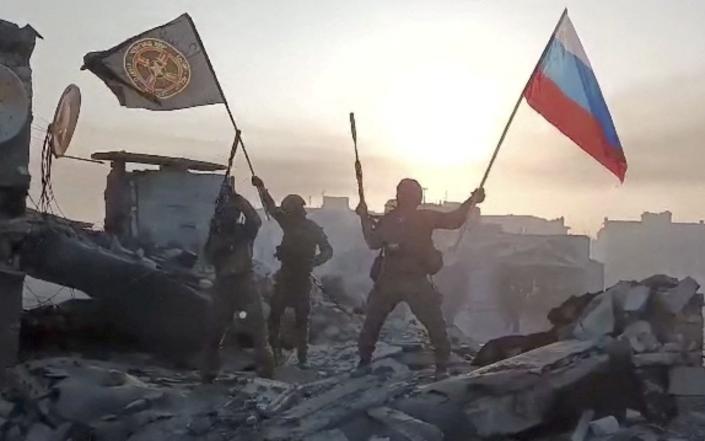
A video circulating this weekend showed a Russian soldier standing alongside a Wagner PMC mercenary, waving the flags of Russia and Wagner in the destroyed Ukrainian city of Bakhmut. Both Vladimir Putin and Wagner chief Yevgeny Prigozhin have claimed victory in the battle for the city.
While Moscow has maintained an unrealistic narrative around its barbarous war, it is sadly plausible that its forces have finally captured Bakhmut at an enormous cost in blood and treasure. And, if indeed true, it will have been achieved primarily by the Wagner group. While their brutality has been widely decried and their effectiveness denigrated, they have proved themselves on the battlefield.
The Wagner group is being used in a very specialised role: its soldiers do assault, and only assault. They’ve adapted their tactics over months of gruelling warfare, and despite high-profile clashes between Prigozhin and the Russian military, they clearly have strong communications with the regular army’s artillery units.
A Wagner assault has a battle-tested pattern. Multiple three to five-man assault teams, well equipped relative to the conscripts in the Russian army, will assault heavily fortified defensive Ukrainian positions, usually manned by platoon-sized numbers of soldiers. They tend to pin down Ukrainians with fire and locate the position, and then the shells will start coming in. Behind the assault teams are more experienced “blocking” units, who shoot anyone trying to retreat – a grim reminder of the Soviet-era doctrines still common in modern Russian military thinking.
There is a crucial distinction to be drawn between the mercenaries and their regular military counterparts, who are now often poorly trained boys. They are rubbish fighters who have been pulled off the street and do not want to be there. The better trained Wagner men, by contrast, do not lack fighting motivation. These soldiers are hardened criminals. Murderers, rapists and armed thugs, pulled from Russian jails and given a reason to fight by a possible future pardon.
When the first assault team is dead, Wagner’s commanders send another. And another. And another. They have a significant numerical advantage and are unafraid of using it. Lives, like shells, are simply a resource to be expended. From a Western perspective this is absolutely incoherent: in our strategies, a platoon-sized objective would be assaulted by a company, with the ratio of attacking to defending soldiers around 3:1. Nevertheless, Wagner’s tactics, unencumbered by concern for human life, seem to have worked. Bit by bit, they grind down the Ukrainian defences.
And as always in an industrialised land campaign, over the top you have the artillery fire from the regular army. The ability to still call in tremendous amounts of earth-shattering artillery has remained a central focus of Russian doctrine; it is first and foremost an artillery-dominant army. But while the sheer number of shells it is able to fire is impressive, the ability to sustain such numbers in the long term is questionable as Western sanctions have begun to bite into Russia’s industrial capacity.
This war, the world’s most brutal in more than half a century, has largely been a war of attrition. In Bakhmut, the objective has simply been to inflict as many casualties as possible on the enemy’s forces. The convicts of the Wagner group, simultaneously hardened and expendable, make perfect fodder for such battles.
Warfare has been this way since the great battles on the Western Front more than a century ago. Suppress and soften up with artillery and airstrikes, then send in infantry to storm the trenches and the defended positions. Ultimately, this is how land campaigns are decided; by the ability to take and hold vital ground. This is how wars are won. In the first Gulf War in 1991, and even the invasion of Iraq in 2003, the British Army stormed Iraqi trenches. Such fighting is brutal, unpleasant and a potent reminder that while in many ways society has evolved in the last hundred years, warfare has not.
It is still characterised by men killing other men, by the storming of defensive positions too tight to wield a rifle effectively, with pistols or automatic fire, and then often in hand-to-hand combat with entrenching tools, knives and fists, all in order to take and hold ground.
From shattered cityscape to defensive line, the battle for Bakhmut was always going to be a form of warfare to which the Wagner group’s brutal tactics were well suited. In this long war, we will almost certainly see the lessons it learned replicated in the struggle to take other important cities. As insane as the Wagner group may seem to Western observers, it may yet hand Putin victory at an immense cost in Russian lives. It would be a price he is more than willing to pay.
Robert Clark is director of the defence and security unit at Civitas

